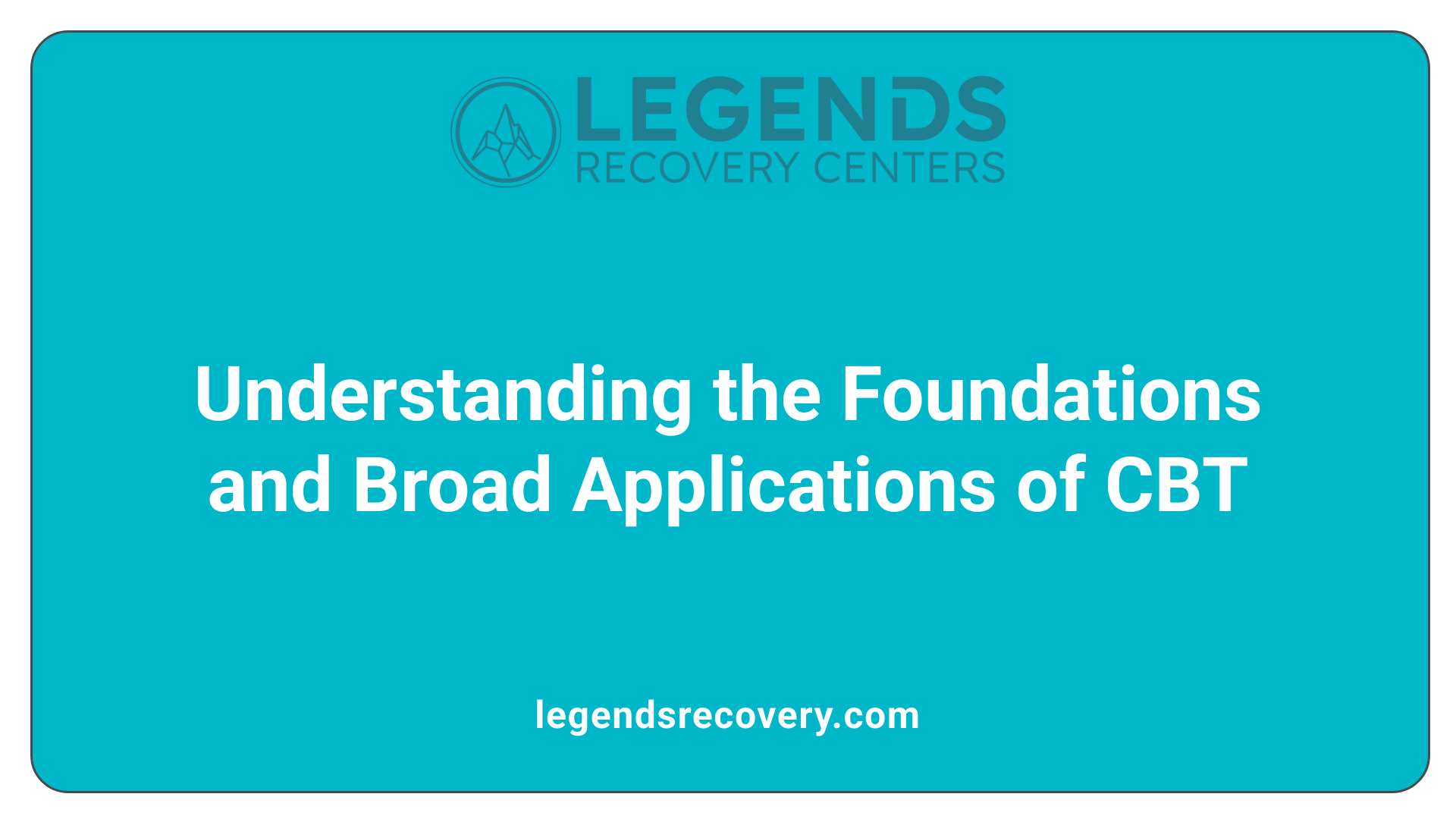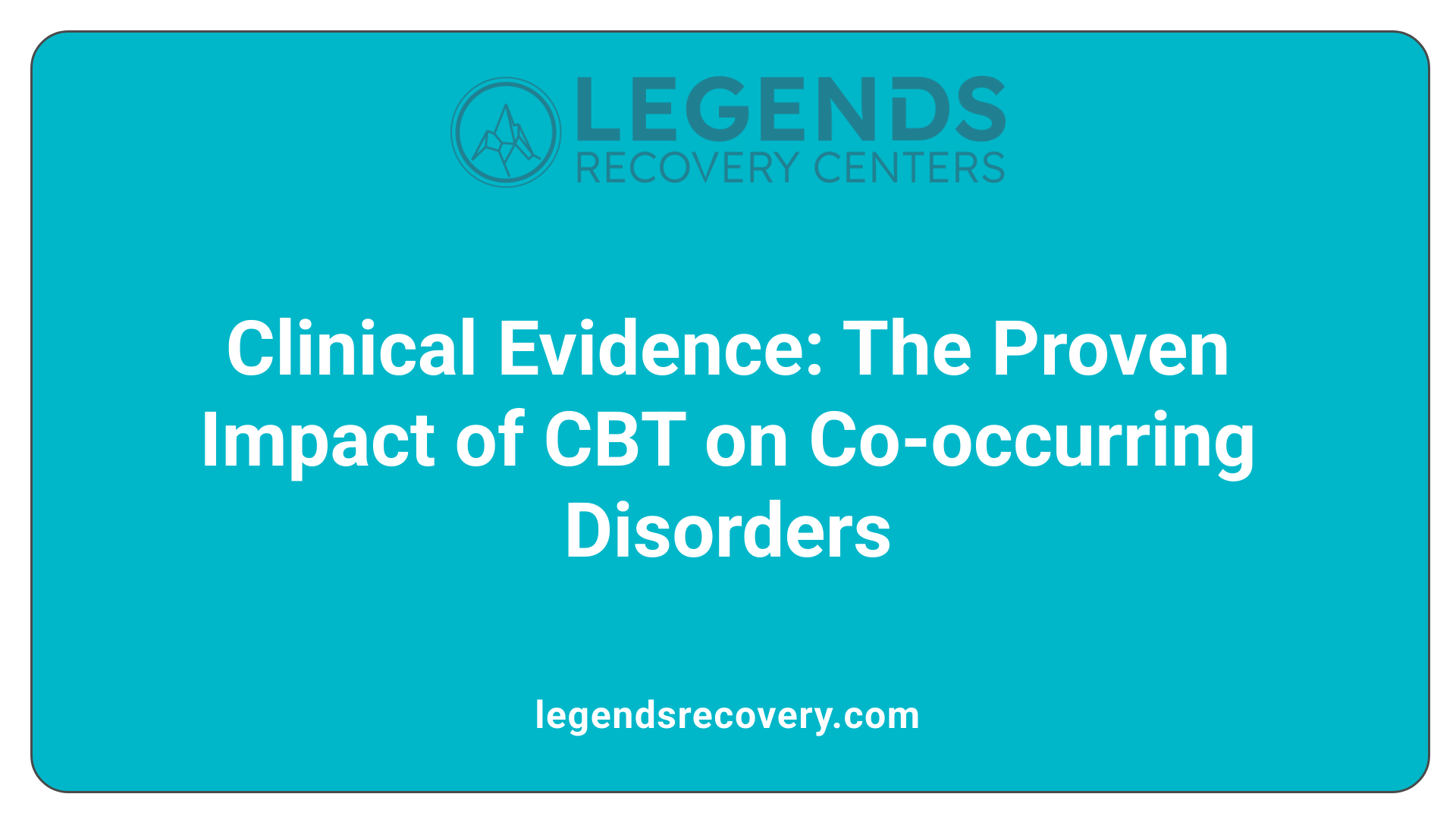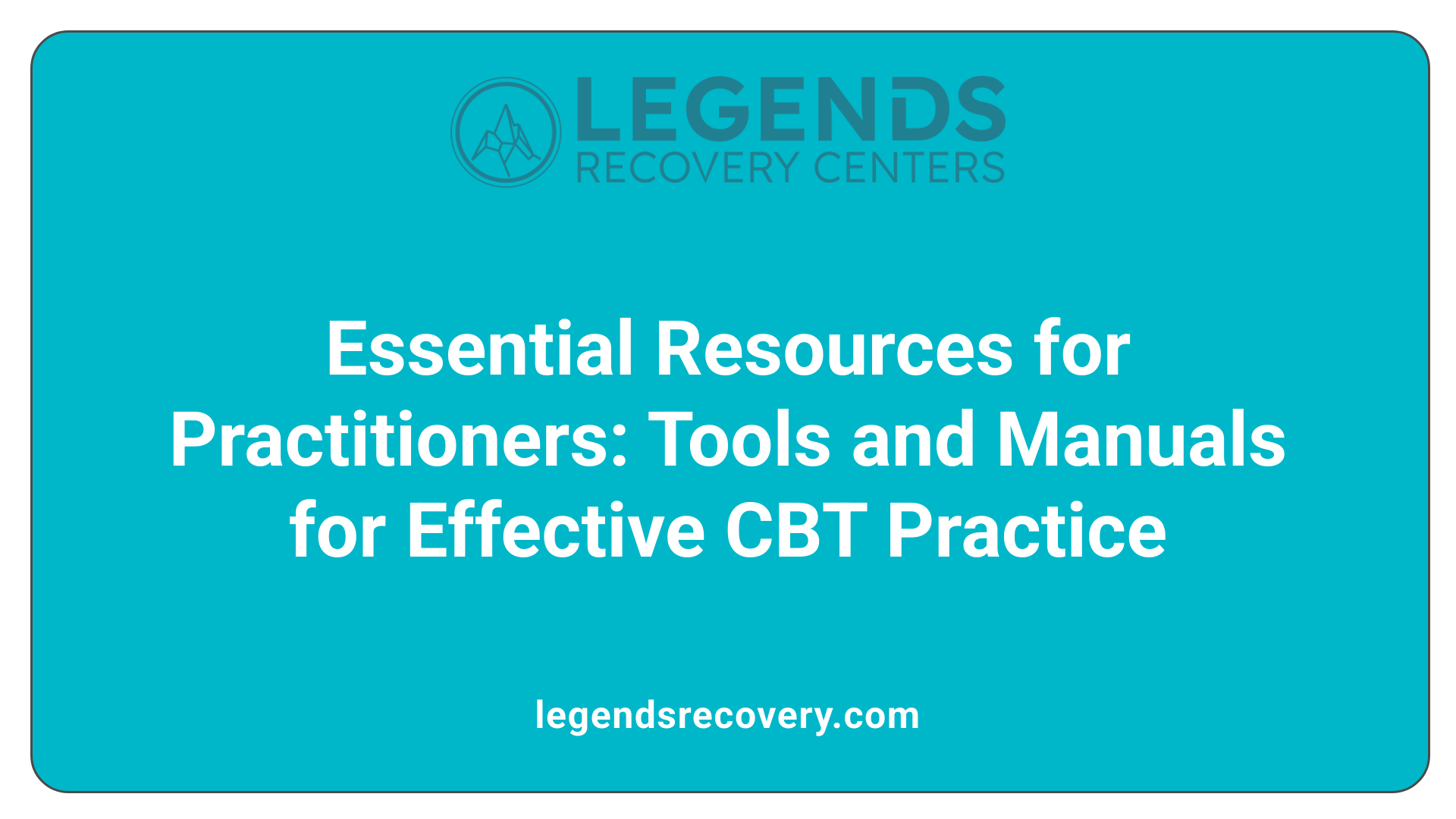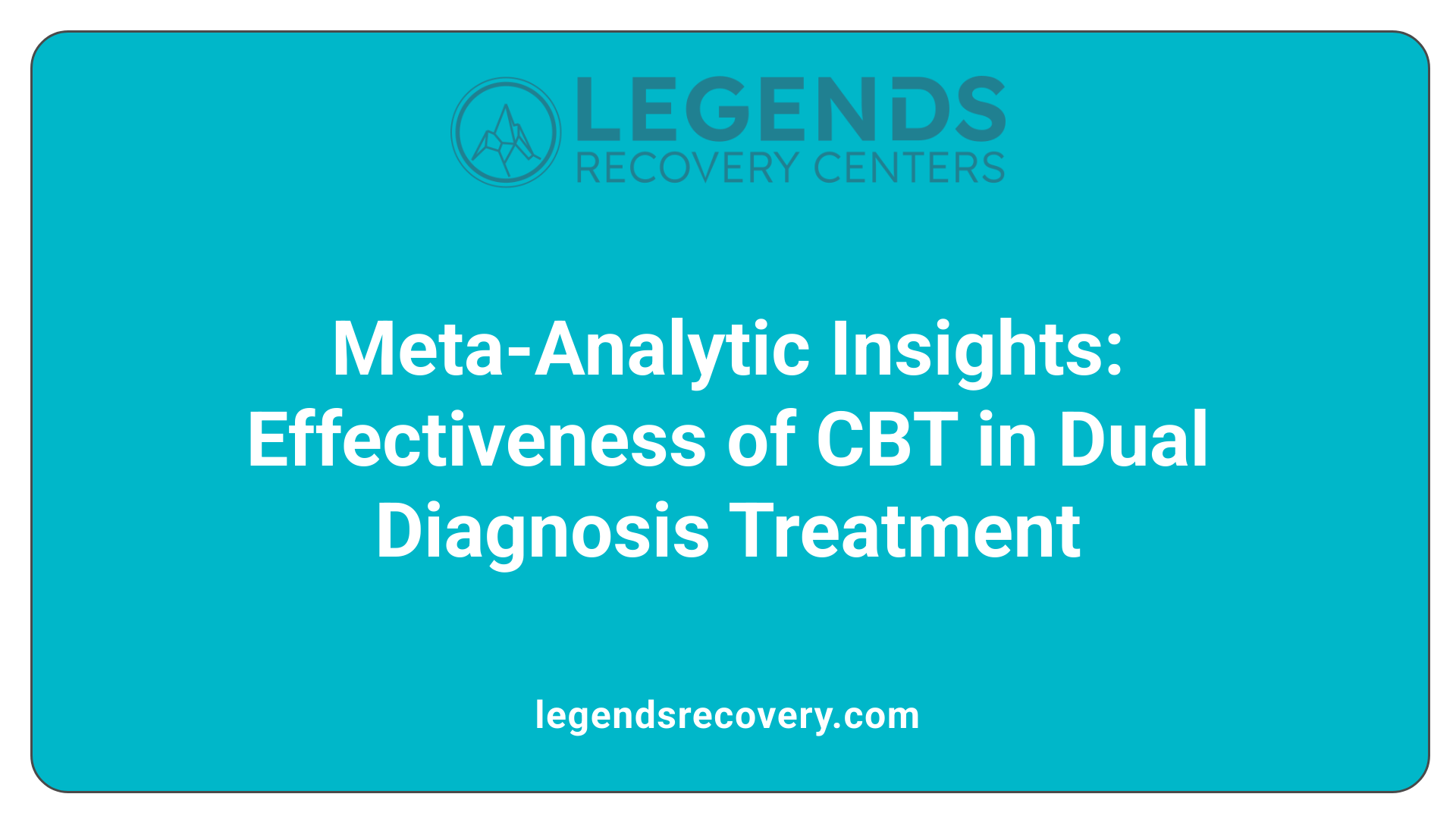Understanding the Vital Role of CBT in Managing Dual Diagnoses

Cognitive-behavioral therapy (CBT) has established itself as a cornerstone in treating co-occurring mental health and substance use disorders. This comprehensive review navigates the scientific evidence supporting CBT's effectiveness, explores clinical strategies, available resources for practitioners, and discusses the treatment's versatility across diverse populations. By examining systematic reviews, research findings, and real-world applications, this article underscores CBT's critical role in enhancing outcomes for individuals battling dual diagnoses.

Cognitive-behavioral therapy (CBT) has a broad application across mental health and some physical conditions. It is especially effective for disorders like depression, anxiety, PTSD, OCD, eating disorders, and substance use issues. The therapy is also utilized for managing bipolar disorder and severe mental illnesses.
Beyond mental health, CBT has shown usefulness in addressing behavioral problems such as gambling addiction, smoking, and weight management. Short-term benefits have been observed in physical conditions like chronic fatigue syndrome, fibromyalgia, irritable bowel syndrome, and even breast cancer symptoms.
CBT’s reputation as a first-line treatment stems from a substantial base of research that consistently demonstrates its effectiveness. Major clinical guidelines endorse its use, emphasizing its role in reducing symptoms and improving functioning by targeting faulty beliefs and maladaptive behaviors.
This therapy's structured approach makes it suitable for short-term intervention, focusing on helping individuals identify, challenge, and change negative thoughts and behaviors.
CBT is built upon several fundamental ideas. Firstly, it assumes that our thoughts, emotions, and behaviors are interconnected, and that by modifying dysfunctional thoughts, we can influence emotions and behaviors positively.
Secondly, it emphasizes the importance of present-focused problem-solving rather than dwelling on past causes. The goal is to develop practical skills that clients can apply immediately.
Thirdly, CBT relies on structured techniques such as cognitive restructuring, behavioral activation, and exposure therapy, which are tailored to individual needs.
Finally, it encourages active participation from clients, fostering self-awareness and promoting the development of effective coping strategies.
CBT’s effectiveness lies in its focus on maladaptive cognitions—distorted or unhelpful thought patterns—and harmful behaviors.
Clinicians guide patients through identifying these negative thoughts, examining their validity, and challenging them logically. Patients learn to replace distorted beliefs with healthier perceptions.
Additionally, CBT involves behavioral strategies such as facing fears gradually, role-playing scenarios for skill development, and practicing relaxation techniques. These methods aim to reduce avoidance behaviors and promote adaptive responses.
By addressing both thoughts and actions, CBT helps create new neural pathways that support healthier thinking and behavior patterns, which is particularly beneficial for managing co-occurring disorders like depression and substance dependence.
Meta-analyses and systematic reviews reinforce CBT’s reputation as an evidence-based treatment. Its applications extend across diverse groups and can be delivered in person or via technology platforms, ensuring wide accessibility.
This combination of theoretical foundations and practical techniques makes CBT a versatile and scientifically supported approach for treating a variety of mental health conditions and co-occurring disorders.
Research has shown that CBT is a reliable treatment option for individuals dealing with both mental health issues and substance use disorders simultaneously. Clinical trials and meta-analyses consistently support its use, revealing small to moderate reductions in substance use across various substances such as alcohol, cannabis, opioids, and stimulants.
Meta-analyses of high-quality studies indicate that CBT produces meaningful effects compared to inactive treatments. For example, many studies reported effect sizes in the moderate range, with around 60% of patients maintaining abstinence at one-year follow-up. The therapy works by helping clients identify maladaptive thoughts, manage triggers, and develop coping strategies, thereby reducing reliance on substances and alleviating mental health symptoms.
CBT’s versatility is evident in its ability to adapt to different formats, including face-to-face and digitally delivered interventions. For instance, recent reviews reveal that technology-based CBT yields similar benefits to traditional, in-person therapy.
While some studies suggest that the effects of CBT diminish slightly over time, early post-treatment outcomes (1–6 months) tend to be more robust compared to longer-term follow-ups.
Meta-analyses report effect sizes ranging from small to moderate when comparing CBT with control treatments. This suggests that CBT has a tangible, though not large, impact on reducing substance use and improving psychiatric symptoms.
For example, a systematic review published in the Journal of Substance Abuse Treatment highlighted a moderate effect size (g ≈ 0.3) for CBT in decreasing substance use behaviors. These findings support CBT’s role as a scientifically validated treatment with real-world applications.
When directly compared to other interventions, CBT often shows larger effects than inactive or minimal interventions. However, its superiority over other evidence-based therapies like motivational interviewing or 12-step programs varies across studies, with some indicating comparable effectiveness.
Additionally, combined treatments—pairing CBT with medications—can further enhance outcomes, particularly in terms of abstinence and relapse prevention.
Even so, some meta-analyses suggest that the added benefits of combining CBT with pharmacotherapy are modest, highlighting the importance of individualized treatment planning.
The overall evidence underscores CBT’s robust, adaptable, and empirically supported role in managing co-occurring mental health and substance use disorders. Its proven effectiveness across diverse populations and delivery methods makes it a cornerstone of modern integrated treatment approaches.
More information can be found through meta-analyses studying CBT outcomes in dual diagnosis treatment.
In cognitive-behavioral therapy (CBT) for co-occurring disorders, therapists employ a variety of targeted strategies to effectively address both mental health conditions and substance use behaviors. One foundational approach is functional analysis of triggers, which helps patients identify the environmental, emotional, or cognitive cues that lead to problematic behaviors. This analysis allows individuals to recognize patterns that maintain their disorders.
A core component of CBT is cognitive restructuring. This technique involves helping patients examine and challenge distorted thoughts and beliefs that contribute to their symptoms. By replacing maladaptive thoughts with healthier perspectives, patients can reduce emotional distress and decrease the impulse to use substances.
Behavioral activation and skills training are also key, encouraging individuals to engage in positive activities and develop adaptive coping mechanisms. These skills include relaxation techniques, role-playing scenarios, and stress management strategies, all aimed at reducing vulnerability to relapse.
Relapse prevention strategies, including motivational interviewing, play a crucial role in maintaining gains from therapy. Motivational interviewing helps enhance internal motivation and commitment to change, making it easier for patients to adhere to treatment plans.
To reinforce long-term treatment outcomes, contingency management provides tangible incentives for abstinence and ongoing engagement in therapy. Psychoeducation about the effects of substances and mental health conditions further empowers patients to understand their experiences and the importance of sustained change.
Therapists often combine these interventions into personalized treatment plans, carefully tailoring approaches based on each individual's unique needs. Overall, these integrated strategies work synergistically to help individuals reduce substance use, manage psychiatric symptoms, and build healthier living patterns.
 Numerous clinical studies have provided strong evidence for the effectiveness of cognitive-behavioral therapy (CBT) in treating co-occurring disorders like substance use, depression, and PTSD. For instance, a study involving 11 patients with PTSD and substance use disorders showed that CBT significantly reduced PTSD symptoms, with only 27% still meeting PTSD criteria post-treatment and 20% at the three-month follow-up. Importantly, substance use also decreased, indicating the dual benefits of this approach.
Numerous clinical studies have provided strong evidence for the effectiveness of cognitive-behavioral therapy (CBT) in treating co-occurring disorders like substance use, depression, and PTSD. For instance, a study involving 11 patients with PTSD and substance use disorders showed that CBT significantly reduced PTSD symptoms, with only 27% still meeting PTSD criteria post-treatment and 20% at the three-month follow-up. Importantly, substance use also decreased, indicating the dual benefits of this approach.
Another trial involving adolescents with substance misuse and psychiatric symptoms found small to moderate reductions in heavy drinking and marijuana use after applying an adapted integrated CBT. Although the results were modest, there was a notable decrease in juvenile justice contacts, suggesting behavioral improvements. These findings highlight that while more intensive or parental involvement might enhance outcomes, CBT remains a promising intervention.
Patient engagement and retention rates tend to be favorable, reflecting CBT’s tolerability and acceptability. For example, a Swedish study of 35 outpatients reported high effect sizes in reducing depression and anxiety, along with increased self-esteem and hope, especially among women. Such engagement is crucial for successful long-term recovery.
Beyond individual studies, meta-analyses consistently demonstrate moderate effects of CBT on reducing substance use, especially when compared to inactive controls. Effects tend to diminish over time, emphasizing the importance of ongoing treatment or booster sessions. Evidence also shows that technology-delivered CBT—whether via smartphone apps or online platforms—can produce effects comparable to traditional in-person therapy.
Overall, the accumulated scientific data confirms that CBT is an effective, versatile treatment for co-occurring disorders. It not only decreases symptoms but also improves motivation, relapse prevention, and overall quality of life for diverse populations.
| Study Type | Focus Area | Outcomes | Follow-Up Period | Effect Size | Additional Notes |
|---|---|---|---|---|---|
| Clinical Trial | PTSD & Substance Use | PTSD severity, Substance use | 3 months | Significant decrease | Showed reduction in PTSD and substance use |
| Adolescents Study | Substance misuse & psychiatric symptoms | Heavy drinking & marijuana use | Not specified | Small to moderate | Fewer juvenile justice contacts |
| Meta-Analysis | General substance use | Reduction in use | Varies | Moderate | Larger effects compared to inactive controls |
| Swedish Outpatient Study | Depression & Anxiety | Symptom reduction, Self-esteem | Post-treatment & 3 months | High effect sizes | Gender differences observed |
Questions for Practitioners and Patients
What resources are available for practitioners or individuals interested in CBT for substance use and co-occurring disorders? Practitioners and individuals can access a variety of resources, including evidence-based manuals, worksheets, and assessment tools. Open-access instruments such as the Child and Adolescent Trauma Screen (CATS), PTSD Checklist, and depression questionnaires aid in thorough assessment. Psychoeducational materials, workbooks, and online platforms like Therapist Aid offer customizable worksheets like 'Urge Surfing' and 'Triggers' that help manage cravings and high-risk situations. Structured manuals such as the 'Anger Management for Substance Use Disorder and Mental Health Clients' provide treatment frameworks and exercises, many available as free downloads, to facilitate evidence-based practice. Search terms like "CBT resources for practitioners and clients" can lead to comprehensive toolkits and guides for effective intervention.
 Practitioners and individuals interested in CBT for substance use and co-occurring disorders have access to a variety of valuable resources designed to support effective treatment. These include evidence-based manuals, worksheets, assessment tools, and structured treatment models.
Practitioners and individuals interested in CBT for substance use and co-occurring disorders have access to a variety of valuable resources designed to support effective treatment. These include evidence-based manuals, worksheets, assessment tools, and structured treatment models.
A range of open-access assessment instruments can help clinicians evaluate trauma, depression, PTSD, and other relevant conditions. Tools like the Child and Adolescent Trauma Screen (CATS), PTSD Checklist, and standardized depression measures assist in accurate diagnosis and personalized intervention planning.
In addition to assessment tools, there are numerous psychoeducational materials and workbooks that cover topics such as trauma, PTSD, and mental health-related stress. These resources are suitable for use by clinicians, caregivers, and clients seeking to understand and manage their conditions more effectively.
Digital platforms such as Therapist Aid provide customizable worksheets that support clients in managing triggers, cravings, and behavioral patterns. Examples include "Urge Surfing," which helps individuals observe and manage cravings, and "Triggers," which aid in identifying environmental cues that lead to substance use.
Furthermore, key manuals like the "Anger Management for Substance Use Disorder and Mental Health Clients" CBT guide offer structured group treatment models. These manuals often include practical exercises, session plans, and therapeutic strategies that facilitate implementation of evidence-based practices.
Many of these resources are freely available online, making them accessible to a broad range of practitioners and treatment programs. This supports a standardized, research-informed approach to addressing co-occurring disorders through CBT.
In summary, the availability of comprehensive assessment tools, educational materials, and structured manuals equips clinicians with essential resources to deliver effective CBT interventions for substance use and mental health conditions, ultimately enhancing treatment outcomes.
While cognitive-behavioral therapy (CBT) has a robust evidence base supporting its use across many populations, certain groups may experience reduced effectiveness due to specific characteristics or circumstances.
Elderly individuals, especially those with dementia or other neurological conditions, might find CBT less accessible due to cognitive impairments that hinder learning and applying new coping strategies. For these populations, modifications to the traditional CBT approach are often necessary to accommodate cognitive limitations.
Cultural sensitivity plays a vital role when implementing CBT in diverse groups. Research indicates that standard CBT, developed primarily within Western contexts, might not fully resonate with ethnic minorities or immigrant populations. These groups can benefit from culturally adapted CBT interventions that incorporate relevant cultural beliefs, values, and language.
Such adaptations may include integrating culturally specific psychoeducation, addressing systemic issues like microaggressions or discrimination, and involving community stakeholders in treatment planning. Evidence shows that culturally tailored CBT tends to yield better engagement and improved outcomes compared to generic approaches.
Furthermore, adaptations for different age groups include tailored language, developmental considerations, and relevant examples to better address the unique challenges faced by children, adolescents, adults, and older adults.
| Population Group | Effectiveness of Standard CBT | Suggested Adaptations | Additional Notes |
|---|---|---|---|
| Elderly (with cognitive impairments) | Limited due to cognitive decline | Cognitive accommodations, simplified language, caregiver involvement | May need different therapeutic modalities in some cases |
| Ethnic minorities & immigrants | Varied; sometimes less effective | Cultural tailoring, language translation, culturally relevant examples | Evidence supports improved outcomes with adaptation |
| Children & adolescents | Effective when developmentally appropriate | Use of play therapy, visual aids, involving family | Tailoring techniques enhance engagement |
Overall, while CBT remains a versatile and effective treatment, recognizing and adjusting for cultural and cognitive factors can significantly improve its applicability and success in diverse populations.
Research demonstrates that clinicians' awareness of cultural backgrounds and readiness to modify treatment approaches are essential. This ensures that CBT continues to be a highly effective option across various demographic groups, enhancing mental health outcomes for all.
 Numerous systematic reviews and meta-analyses have investigated the effectiveness of cognitive-behavioral therapy (CBT) for individuals with co-occurring mental health and substance use disorders. One comprehensive review analyzed five meta-analyses focusing on CBT's outcomes in reducing substance use. These analyses generally show small to moderate effects, with the most pronounced benefits occurring within the first 1 to 6 months post-treatment. Such early follow-up results suggest that CBT is especially effective in the initial stages of recovery.
Numerous systematic reviews and meta-analyses have investigated the effectiveness of cognitive-behavioral therapy (CBT) for individuals with co-occurring mental health and substance use disorders. One comprehensive review analyzed five meta-analyses focusing on CBT's outcomes in reducing substance use. These analyses generally show small to moderate effects, with the most pronounced benefits occurring within the first 1 to 6 months post-treatment. Such early follow-up results suggest that CBT is especially effective in the initial stages of recovery.
A large-scale meta-analysis encompassing 47 randomized trials compared cognitively-based interventions, including CBT, to usual care for populations dealing with alcohol or drug use alongside mental health issues. The findings revealed that about 65–79% of participants experienced improvements, including reductions in substance consumption and psychiatric symptoms. Notably, these reviews highlight that integrated CBT approaches can significantly enhance treatment outcomes, such as abstinence, adherence to medication, and relapse prevention.
The quality of these systematic reviews varies but overall supports the use of CBT as an evidence-based treatment component for co-occurring disorders. They underscore that while effects may diminish somewhat over extended periods, early benefits are robust and clinically meaningful. These findings align with clinical practice guidelines, emphasizing the importance of early intervention with CBT techniques to address maladaptive thoughts and behaviors associated with dual diagnoses.
In summary, the evidence from meta-analyses affirms that CBT and related behavioral therapies offer tangible benefits for individuals with co-occurring mental health and substance use disorders. Their effectiveness is most evident in the short-term follow-up, with consistent indications across multiple high-quality reviews that these approaches should be integral to comprehensive treatment plans.
Cognitive-behavioral therapy (CBT) employs various techniques to effectively address both mental health issues and substance use behaviors in individuals with co-occurring disorders. A fundamental approach is the functional analysis of triggers — helping patients identify specific thoughts, emotions, and environmental cues that lead to substance use or psychiatric symptoms.
Therapists then use skills training to teach coping mechanisms, such as relaxation techniques, problem-solving, and behavioral activation, which enable patients to manage stress and cravings more effectively.
Cognitive restructuring is a core component of CBT, focusing on challenging and changing distorted or maladaptive thoughts. This process helps alter negative perceptions related to both mental health and substance use, fostering a more positive outlook.
Relapse prevention strategies are integrated to help patients recognize warning signs of relapse and develop plans to maintain progress. These include identifying high-risk situations, practicing avoidance tactics, and developing a strong support network.
Motivational interviewing is often combined with CBT to enhance the individual's motivation to engage in treatment and sustain behavior change. It involves exploring ambivalence and reinforcing the patient's own reasons for change.
Contingency management uses tangible incentives to reinforce abstinence and participation in therapy, increasing treatment adherence.
Overall, therapists tailor intervention plans to the unique needs of each patient, combining psychoeducation about mental health and substance use, teaching effective coping skills, and fostering behavioral change. These strategies work synergistically to improve engagement, reduce relapse odds, and promote healthier, more stable behaviors in individuals facing co-occurring disorders.
Practitioners and individuals interested in cognitive-behavioral therapy (CBT) for substance use and co-occurring disorders have access to a wealth of valuable tools and materials. These include evidence-based manuals, assessment instruments, and worksheets designed to facilitate effective treatment planning and implementation.
For assessment purposes, open-access tools such as the Child and Adolescent Trauma Screen (CATS), PTSD Checklist, and depression measures help clinicians accurately evaluate clients’ needs. These instruments allow for tailored interventions by providing reliable data on symptom severity and specific issues.
Educational resources are also widely available. Numerous psychoeducational materials and workbooks focus on trauma, PTSD, and mental health topics, suitable for both clinicians and patients. These materials support understanding and engaging with treatment concepts, which is crucial for co-occurring disorders.
Online platforms like Therapist Aid offer a variety of customizable worksheets. Popular tools such as 'Urge Surfing', which helps manage cravings, 'Triggers', to identify and cope with risk factors, and 'Habit Plan' for behavioral change, are practical aids for clients. These worksheets facilitate skill development in real-life situations, promoting lasting change.
Structured treatment models are exemplified by manuals like the 'Anger Management for Substance Use Disorder and Mental Health Clients' CBT manual. This resource provides detailed exercises and group treatment protocols, often available as free downloads. Such manuals support clinicians in delivering standardized, evidence-based care that enhances treatment outcomes.
Overall, the availability of diverse, accessible resources empowers both practitioners and clients to optimize CBT interventions for co-occurring substance use and mental health conditions.
Cultural competence plays a crucial role in enhancing the effectiveness of cognitive-behavioral therapy (CBT) across diverse populations. When clinicians understand and respect clients’ cultural backgrounds, they can tailor interventions to align with clients’ values, beliefs, and social contexts. This fosters better communication, increased engagement, and improved treatment outcomes.
Adapting CBT for diverse groups involves incorporating culturally relevant psychoeducation, addressing culturally specific stressors such as microaggressions or systemic marginalization, and respecting cultural expressions of distress. Techniques may include translating therapeutic materials, acknowledging cultural healing practices, and involving family or community members when appropriate. Culturally adapted CBT has shown to yield better engagement and outcomes, especially when interventions respect clients' linguistic and cultural identities.
Systemic barriers such as lack of access to mental health services, language differences, economic disadvantages, and stigma can hinder the delivery of CBT to marginalized groups. Addressing these barriers requires efforts like increasing service accessibility in underserved areas, providing bilingual therapists, and implementing community outreach programs to reduce stigma.
While CBT is highly effective for many, it may be less effective for certain populations, including elderly patients, individuals with dementia, or those with neurological conditions who face cognitive limitations that hinder engagement with traditional CBT techniques. Marginalized groups, such as ethnic minorities and immigrants, might experience somewhat reduced effects when using standard CBT methods due to cultural mismatches.
However, evidence indicates that culturally sensitive adaptations of CBT — which incorporate culturally relevant psychoeducation, consider systemic stressors, and modify communication styles — can significantly improve outcomes. Clinicians should educate themselves about their clients’ cultural backgrounds and modify their approaches accordingly.
Overall, although standard CBT remains a potent treatment, attention to cultural and systemic factors enhances its applicability and effectiveness for diverse populations.
Searching for "cultural adaptations for CBT in diverse populations" yields valuable studies and guidelines on implementing culturally responsive interventions. These resources advocate for tailored approaches that respect individuals’ backgrounds and address unique systemic barriers, promoting equitable mental healthcare.
Table 1 summarizes considerations for cultural adaptations in CBT:
| Aspect | Consideration | Impact |
|---|---|---|
| Cultural Relevance | Incorporate culturally specific beliefs and values | Enhances engagement |
| Language | Use language that clients understand and feel comfortable with | Improves communication |
| Systemic Factors | Address systemic marginalization and microaggressions | Reduces resistance |
| Delivery Format | Offer flexible delivery modes (e.g., teletherapy, community-based) | Increases access |
| Education and Awareness | Train clinicians in cultural competence and awareness | Improves treatment tailoring |
Employing such strategies ensures that CBT is accessible, respectful, and effective for a broad spectrum of individuals, promoting mental health equity across diverse communities.

Cognitive-behavioral therapy (CBT) has demonstrated effectiveness in addressing both mental health and substance use disorders when used as part of an integrated approach. Its success rate varies across studies and populations but generally shows modest, positive outcomes.
Meta-analyses report that approximately 60% to 80% of individuals with co-occurring disorders experience improvements with CBT. The effect sizes usually fall within the low to moderate range (around d=0.45), indicating that CBT can produce small to moderate effects on reducing substance use and alleviating psychiatric symptoms.
CBT tends to be most effective in the early months following treatment, particularly within 1 to 6 months post-intervention. During this period, reductions in substance use and mental health symptoms are typically most pronounced.
However, there is some evidence that these effects may diminish over longer periods, although many patients maintain gains due to the skill-building aspects of CBT.
Overall, CBT is recognized as an empirically supported treatment that helps improve outcomes in individuals with co-occurring disorders. Its adaptable nature, combined with consistent research backing, supports its continued role in integrated treatment strategies.
Advances in technology have expanded the reach of CBT through digital platforms and telehealth. These formats allow for greater accessibility, especially for individuals in remote areas or those unable to attend in-person sessions.
Studies suggest that technology-delivered CBT has similar effectiveness compared to traditional face-to-face therapy, offering comparable reductions in substance use and psychiatric symptoms.
Research is increasingly focused on refining digital CBT interventions, tailoring treatments for specific populations, and integrating novel techniques such as virtual reality and app-based modules.
Innovative approaches include combining CBT with other therapies, such as Acceptance and Commitment Therapy (ACT) and Dialectical Behavior Therapy (DBT), to enhance treatment outcomes.
Further large-scale, long-term studies are necessary to fully understand the durability of these interventions across diverse populations.
As evidence supports the efficacy of CBT, especially through accessible formats like telehealth, policymakers are encouraged to promote training programs for clinicians in these modalities.
Expanding provider training will help standardize implementation and ensure high-quality care, ultimately improving treatment access and outcomes for individuals with co-occurring disorders.
As extensive research and clinical practice continue to affirm the efficacy of CBT for co-occurring disorders, there is a clear trajectory toward more integrated, accessible, and culturally sensitive treatment models. The evolution of delivery formats, including telehealth and digital platforms, coupled with ongoing research, promises to enhance success rates and broaden reach. Ensuring practitioners are equipped with comprehensive resources and tailored approaches will be crucial in optimizing outcomes across diverse populations. CBT's adaptability and empirical support underscore its role as a vital component in the future landscape of dual diagnosis treatment, offering hope for improved recovery trajectories and quality of life for individuals facing the complexities of co-occurring mental health and substance use issues.